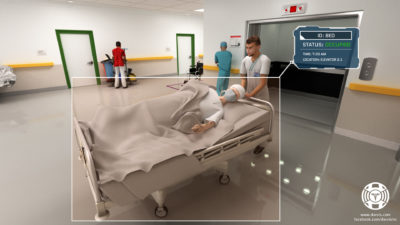After an exhausting 12-hour shift caring for patients, it’s hard to blame frontline workers for forgetting to sing “Happy Birthday” twice to guarantee a full 30 seconds of proper hand-washing.
Though at times tedious, the process of confirming such detailed, protective measures like the amount of time hospital employees spend sanitizing their hands, the cleaning status of a room, or the number of beds available is crucial to preventing the spread of infectious diseases such as COVID-19.
DARVIS, an AI company founded in San Francisco in 2015, automates tasks like these to make hospitals “smarter” and give hospital employees more time for patient care, as well as peace of mind for their own protection.
The company developed a COVID-19 infection-control compliance model within a month of the pandemic breaking out. It provides a structure to ensure that workers are wearing personal protective equipment and complying with hygiene protocols amidst the hectic pace of hospital operations, compounded by the pandemic. The system can also provide information on the availability of beds and other equipment.
Short for “Data Analytics Real-World Visual Information System,” DARVIS uses the NVIDIA Clara Guardian application framework, employing machine learning and advanced computer vision.
The system analyzes information processed by optical sensors, which act as the “eyes and ears” of the machine, and alerts users if a bed is clean or not, or if a worker is missing a glove, among other contextual insights. Upon providing feedback, all records are fully anonymized.
“It’s all about compliance,” said Jan-Philipp Mohr, co-founder and CEO of the company. “It’s not about surveilling workers, but giving them feedback where they could harm themselves. It’s for both worker protection and patient security.”
DARVIS is a member of NVIDIA Inception, a program that helps startups working in AI and data science accelerate their product development, prototyping and deployment.
The Smarter the Hospital, the Better
Automation in hospitals has always been critical to saving lives and increasing efficiency, said Paul Warren, vice president of Product and team lead for AI at DARVIS. However, the need for smart hospitals is all the more urgent in the midst of the COVID-19 crisis, he said.
“We talk to the frontline caregivers, the doctors, the nurses, the transport staff and figure out what part of their jobs is particularly repetitive, frustrating or complicated,” said Warren. “And if we can help automate that in real time, they’re able to do their job a lot more efficiently, which is ultimately good for improving patient outcomes.”
DARVIS can help save money as well as lives. Even before the COVID crisis, the U.S. Centers for Disease Control and Prevention estimated the annual direct medical costs of infectious diseases in U.S. hospitals to be around $45 billion, a cost bound to rise due to the global pandemic. By optimizing infection control practices and minimizing the spread of infectious disease, smart hospitals can decrease this burden, Mohr said.
To save costs and time needed to train and deploy their own devices, DARVIS uses PyTorch and TensorFlow optimized on NGC, NVIDIA’s registry of GPU-accelerated software containers.
“NVIDIA engineering efforts to optimize deep learning solutions is a game-changer for us,” said Warren. “NGC makes structuring and maintaining the infrastructure environment very easy for us.”
DARVIS’s current centralized approach involves deep learning techniques optimized on NVIDIA GPU-powered servers running on large workstations within the hospital’s data center.
As they onboard more users, the company plans to also use NVIDIA DeepStream SDK on edge AI embedded systems like NVIDIA Jetson Xavier NX to scale out and deploy at hospitals in a more decentralized manner, according to Mohr.
Same Technology, Numerous Possibilities
While DARVIS was initially focused on tracking beds and inventory, user feedback led to the expansion of its platform to different areas of need.
The same technology was developed to evaluate proper usage of PPE, to analyze worker compliance with infection control practices and to account for needed equipment in an operating room.
The team at DARVIS continues to research what’s possible with their device, as well as in the field of AI more generally, as they expand and deploy their product at hospitals around the world.
Watch DARVIS in action:
Learn more about NVIDIA’s healthcare-application framework on the NVIDIA Clara developers page.
Images courtesy of DARVIS, Inc.
The post Smart Hospitals: DARVIS Automates PPE Checks, Hospital Inventories Amid COVID Crisis appeared first on The Official NVIDIA Blog.

